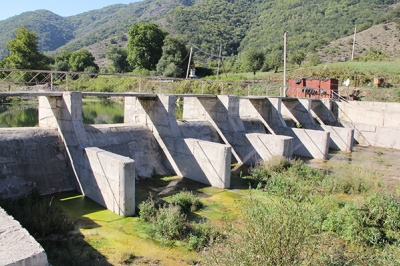

EcoLur
In the framework of the project entitled “Support to SHPP-relating Reforms Through the Dialogue of Public and RA Nature Protection Ministry for Sustainable Use of River Ecosystems” the expert group visited “Tsav” SHPP. “Tsav” SHPP is located in Syunik Region, in the administrative area of Tsav community. The SHPP is constructed on the Tsav River (length – 27 km). It’s operated by “LESOMA” CJSC.
As a result of the monitoring, the expert group found out:
- The SHPP has been operating since 2010.
- The SHPP structures are located in immediate proximity to “Shikahogh” state reserve, probably also in the very area.
- At the moment of observation, the SHPP was not operating.
- According to the company, the static pressure of the SHPP is 315 m, while the project says it’s 314 m. According to the certificate issued by the Public Services Regulatory Committee on 1 January 2016, the estimated pressure of the SHPP is 286.3 m. According to the project and the PSRC certificate, the estimated yield used by the SHPP is 1.2 m3/s. According to the PSRC certificate, the projected capacity is 2740 kW. According to the PSRC, as of 01.01.2016 the factual useful delivery of the electricity is 7.06583 million kWh, the estimated production of the SHPP is 8.63 million kWh, according to the project, duration of license - 04.08.2010-2025, water usage permit - 17.11.2010-17.11.2013.
- The real coordinates of the SHPP comply with the coordinates laid down in the water usage permit, but it’s not true about heights above sea level.
- The length of the SHPP concrete-made dam is 30 m, its height is 3m. The project planned to have length of 38.6 meters and height of 6.2 meters.
- There is a semi-maze cascade fish passway made of concrete in “Tsav” SHPP head section, which is 25.9 meters long, 2.4 meters high and 1.5-1.6 meters wide. There are concrete partitions inside the fish passway, each of which has two holes 35 cm wide. The structure of the fish passway and the amount of the flowing water at the moment of observation was sufficient to ensure the movement of the fish living in the river. During spring floods the abundant water flow in the fish passway will create additional difficulties for the movement of the South Caucasus Sprilin. According to the project, the fish passway should have length of 34 meters, width of 1.5 meters and stairs – 1.5 meters long and 0.8 meter deep.
- There was a net sized 4x5 cm at the entrance part of the pipeline, which couldn’t prevent the passage of the small fish into the pipeline.
- You can meet the following fish species in the upper reach of the Tsav River, where the SHPP head section is constructed: Kura barbell, South Caucasus Sprilin and the rainbow trout ay regularly penetrate into it.
- According to the project, the SHPP pipeline length is 4760 meters, its diameter is 820 mm.
- The percentage correlation of the SHPP derivation pipeline constructed on the Tsav River with the river length makes up 17.46%.
- According to the water usage permit, “Tsav” SHPP can annually carry out water intake in the amount of 11967.0 cum ensuring an environmental flow of 0.1 cum/s.
- The automated management and recording of the environmental flow is not ensured.
- There is no water-meter sealed by a relevant environmental body in the water intake.
- There is a water-meter installed, which hasn’t ever operated.
- There are 3 hydroaggregates installed in the SHPP building of local “Khorda” production, the generators of which are of Soviet production.
- There is a semi-automated system operating in the station.
- There is no automated management system for water level.
- The transformers are not equipped with oil-collecting system.
- According to “Computation Center” CJSC data, in 2014 “Tsav” SHPP operated for 11 months and produced 5601684 kW electricity.
- The station area is improved and greened.
Proposals
1.To correct the data on heights above sea level in the water usage permit.
2.To review the environmental flow of 0.1 cum/s with a tendency to increase it, as it’s two small and can’t ensure the natural state of the Tsav River and the local biodiversity taking into consideration the presence of “Shikahogh” state reserve.
3.To ensure automatic management of environmental flow in the head section, installation of water-measuring devices and online control.
4.To entirely reconstruct the fish passway to ensure the natural migration of the fish.
5.The use of the dam may be refused and to carry out the water intake in another way without blocking the riverbed.
6.As in all other cases of SHPPs operating on small rivers, this SHPP should stop its operation in low-water season.
 |
 |
 |
 |
 |
 |
 |
 |
 |
 |
 |
 |
Photos by Levon Galstyan
The material was developed in the frames of “Supporting reforms in the sector of small hydro power plants through enabling a dialogue between civil society and the Ministry of Nature Protection for sustainable use of river ecosystems” supported by UNDP/GEF Small Grants Programme".
May 02, 2016 at 18:10
